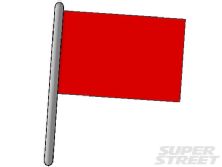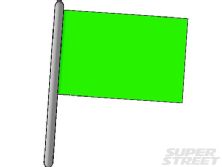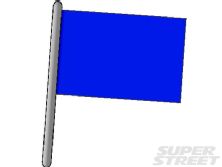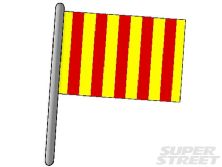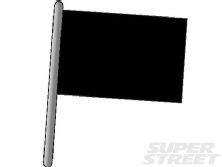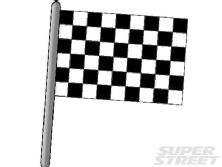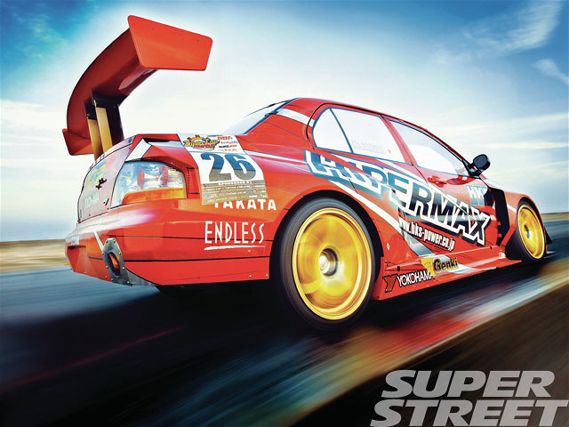 | Chasing The Line - Tech
| Chasing The Line - Tech
Taking your car anywhere near its limits on the public highway will almost certainly wind up with negative consequences. Bless those who build race circuits and drag strips. Whether you want to get involved in serious competition, or just put your skills up against your buddies and the blacktop, nothing beats some serious track time. And with hundreds of circuit and ‘Run What Ya Brung’ days aimed at drivers of all abilities, we’ll take you through some of the basics of car setup and what you’ll need to know if you fancy yourself as the next Stephan Papadakis, Ayrton Senna or your choice of driving legend here.
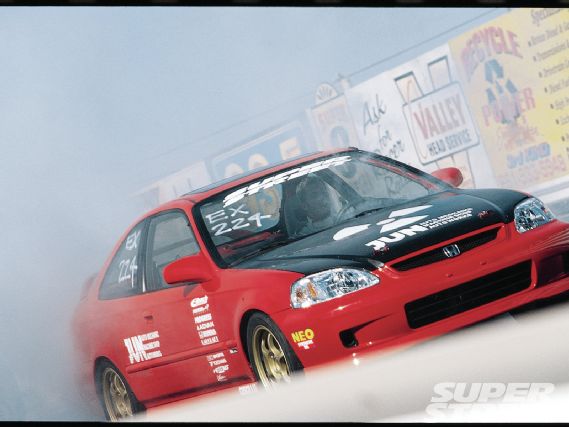 |
Chasing The Line - Tech
|
Chasing The Line - Tech
But pushing your car hard in any form of motorsport involves putting both it and yourself under far more stress, and you need to prepare properly to avoid causing major damage to your ride. If it’s your everyday driver as well, this can really screw things up. So, follow this simple guide and make a few wise investments before you leave the pit lane to make the most of your time and take a lot of the fear out your first competition experience.
Track and Circuit Racing
Assuming your car is in good operating condition (a recent service is recommended), the most important things to worry about are the consumables. If you’re a novice, don’t worry too much about the bolt-on, go-faster goodies, the most important thing by far is to learn your lines, braking points and understand your chosen weapon of choice’s limits. As a perfect example, I’ve seen professional drivers in factory stock Ford Fiestas drive around the outside of tuned Imprezas and Evos on track days and make them look like kids on a play day. You can have all the power in the world, but not knowing how to harness it effectively makes it ultimately useless.
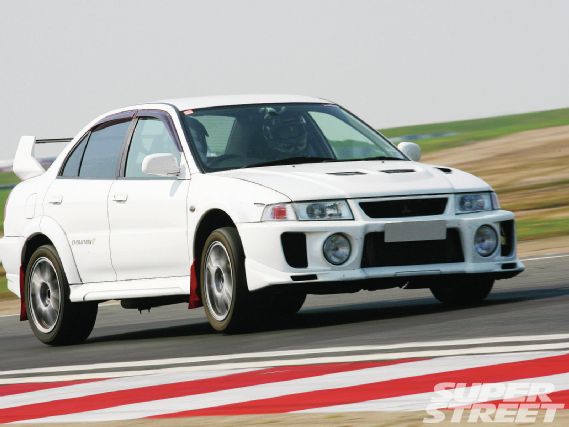 |
Decent track prep doesn’t necessarily mean spending thousands of dollars. Any car can make an effective track weapon in the right hands.
|
Decent track prep doesn’t necessarily mean spending thousands of dollars. Any car can make an effective track weapon in the right hands.
Chassis or engine modifications can sometimes prove counter-productive (we covered this in February’s chassis tuning piece) if you don’t spend serious seat time fine tuning and understanding the reasons behind what you’re doing and why. This knowledge comes from learning from more experienced track fiends and a certain amount of trial and error; why else do you think that top race teams spend so much time and hard-earned dollars on R&D and testing? Bearing that in mind, the basics to look at include:
Fluids: Make sure these are all filled—oil, fuel, brake fluid, coolant—and that the fluid is reasonably fresh as high temperatures are the enemy for any motor. Also check for leaks that could pose a risk to anyone else on the circuit and that you carry spares to the track if you need to top off between sessions.
Brakes: Your pads, rotors, lines and fluids will be under much greater stresses on track as you are braking harder and more regularly from high speeds, increasing the temperatures involved and consequently the wear.
Starting with the pads, we recommend you have at least three-quarters of your pad material remaining across the full surface of the pad before you place a tire on the track. Changing pads while on a track day is far from ideal, and running on wrecked ones will dramatically reduce your stopping ability and increase wear on your rotors. Uprated pads are always worth considering and a fast road/race pad should be more than up to the gig. Race pads are the ultimate choice, but remember, these aren’t designed for road use. You’re going to end up changing them on the day as chances are they won’t be street legal. For any new pad, a decent bedding-in period of 200-300 miles is essential before you give them maximum death on the track.
 |
A set of track day wheels and tires can pay real dividends in terms of bringing down your lap times.
|
A set of track day wheels and tires can pay real dividends in terms of bringing down your lap times.
The same can be said of your fluid. Higher temperatures increase the risk of it boiling in the lines, so make sure at the very least that the fluid is fresh. Brake fluid is hygroscopic, so it absorbs moisture over time, reducing the boiling point. Another important tip is to always use an unopened container, as something that’s been left in the garage for six months will already have absorbed water, drastically reducing its effectiveness. Decent ‘fast road/track’ fluids include Motul 600, ATE Super Blue and AP550 Racing.
Tires: As the first point of contact between your car and the road surface, they need to be in good shape, so 20,000-mile old rubber isn’t recommended. Ensure you have plenty of tread left (you’ll have to drive home on them after) and that the pressures are at the correct recommended levels by the manufacturer. If you’ve got slightly deeper pockets, a set of specific track wheels and tires are a good investment—lightweight alloys will sharpen the steering and give better braking performance, and slick or semi-slick tires will give you better traction. Remember though that tires can and do go ‘off’ if left for extended periods of time so if you do have track wheels and tires, just make sure you check them over—tread and sidewalls—before you fit them for the circuit. Temperature is also a factor. You want some heat to increase grip, but not so much that the tires deteriorate, so a tire pyrometer is always a handy item for the toolbox for measuring pre and post-session (this will also allow you to dial-in pressures). Lastly, and most obviously, make sure that lug nuts are correctly tightened/torqued—three wheels on your wagon is never the fastest way around any circuit!
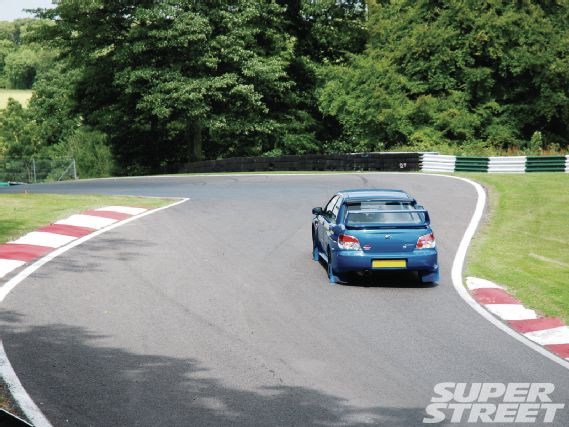 | Chasing The Line - Tech
| Chasing The Line - Tech
Chassis: A lot of this was covered in February’s chassis tuning guide, but for most circuits you want to ensure no extreme bias to either end of the vehicle to keep it as flat as possible, and reduce the center of gravity. The latter is done by winding those coilovers down (never, EVER chop springs); not so far as to induce the dreaded bumpsteer, but enough to bring the car closer to the tarmac and improve the aerodynamics—after all how many racecars do you see riding like monster trucks?
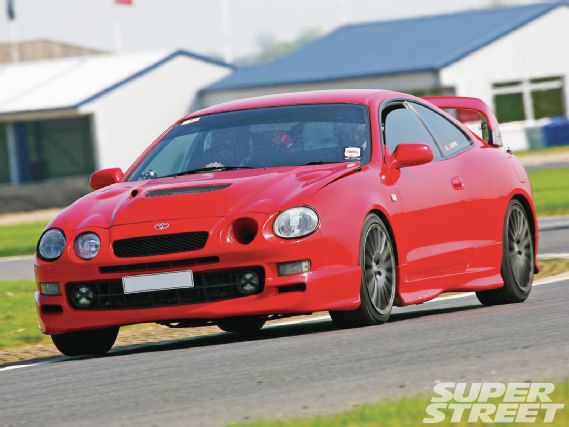 |
Hood spacers and headlight scoops are a great and relatively inexpensive way of making sure air circulates properly in the engine bay, as well as improving intake airflow.
|
Hood spacers and headlight scoops are a great and relatively inexpensive way of making sure air circulates properly in the engine bay, as well as improving intake airflow.
If you do have camber and caster adjustments, these can be beneficial, but should be done on a track-by-track basis and incrementally so you can determine what is working and what isn’t. Changing everything in one pit session can often destroy your times and leave you scratching your head as to what is working or why your car all of a sudden handles like a pig. Make sure all mounting points and bushes are in decent shape and secured so nothing is likely to fall off mid-lap, this includes steering and suspension bushes and rubber exhaust mounts.
Bodywork: For both standard bodies and aftermarket aero parts, make sure everything is securely fitted with nothing hanging loose (body panels, under-body shields and wheel fender liners) and ideally that the headlights are taped up. Racers do this to prevent rock chips shattering the lenses and littering the track with plastic or glass that can pose a hazard to other drivers. If you’ve got the budget, replacing panels with carbon-fiber items helps reduce weight, not to mention look cool as hell; the same goes for Plexiglass or Lexan windows.
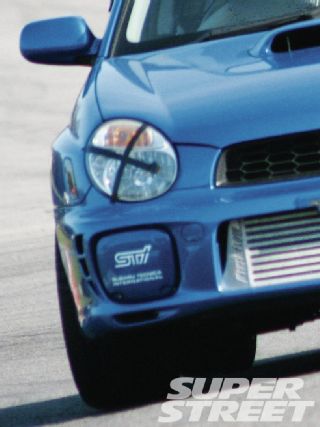 |
Taping up headlights is always recommended, some track day organizers insist on it.
|
Taping up headlights is always recommended, some track day organizers insist on it.
Interiors: Inside the car, empty all your door pockets, glovebox and trunk and get rid of all the empty Red Bulls and Big Mac wrappers as nothing is more distracting when you need all your concentration than crap rattling around. Plus, sunglasses and CD cases flying past your ears or under the pedals when you’re braking hard from 100mph into those tight esses is downright hazardous. Taking it to the next level, ditching unnecessary weight like the rear bench seat and plastic trim panels are always a good idea—as a general rule, if it can be removed easily in 15 minutes and won’t affect the car’s safety, then get rid of it.
More performance-oriented modifications like a smaller, more ergonomic steering wheel and shifter (even a short-shift kit) as well as bucket seats and four, five or six-point harnesses will keep you planted and allow you to concentrate fully on going faster and not on shifting your ass from the passenger seat back to where it should be on exiting that fast left-hander.
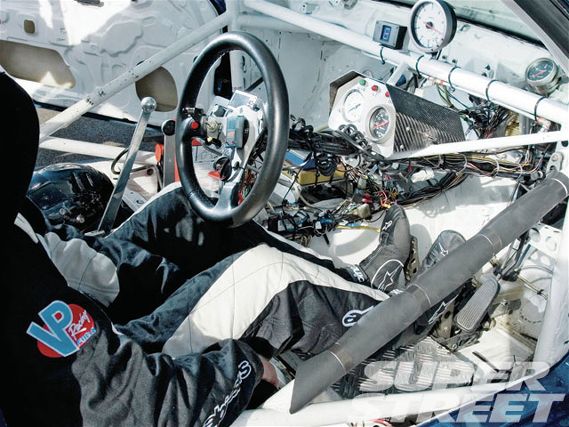 |
Chasing The Line - Tech
|
Chasing The Line - Tech
A rollcage is always a wise move. Motorsport-ready SCCA and NASA-approved cages can be bought for as little as $500. Again, this depends on how much track time you wish to indulge in and the practicality you require from your road car.
Some track days will allow you to record your motorsport glory with an on-board camera, and if this is the case it must be securely mounted without causing an obstruction. Most organizers will also want you to sign a disclaimer that states the footage is for private use only—not for posting on the worldwide web.
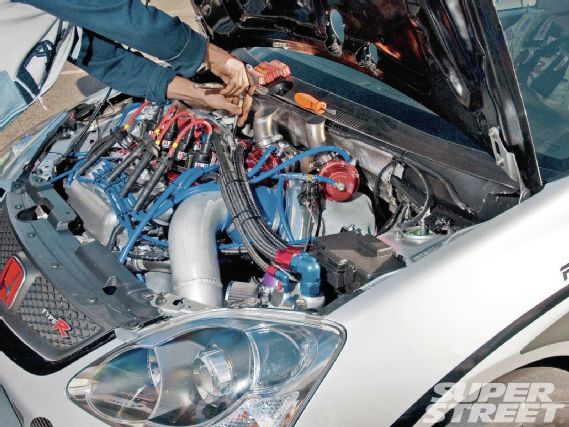 | A simple toolkit will allow you to make any adjustments in between sessions.
| A simple toolkit will allow you to make any adjustments in between sessions.
Post-Session Tips
• Once the session or race is over, always complete a cool down lap to get some air to the brakes, engine and transmission.
• Another simple but important lesson learned from my own bitter experience is to never put the parking brake on when you stop in the pits. If you’ve been giving the brakes serious amounts of abuse, the hot pads can fuse themselves to the rotors and will be a bitch to release.
• Opening the hood will circulate more air to the engine bay to help cool it more quickly and more evenly; also take the opportunity (after 10-15 minutes rest) to check the fluid levels. This may reveal any leaks before they become a more serious (and expensive) issue.
• Check the tires again for nicks and cuts to the treads, sidewalls and shoulders. After allowing them to cool for a few minutes, check the pressures again, and the wheelnuts and anything else has that may have worked itself loose.
Circuit Rules and Etiquette
At the track you’ll receive a briefing that covers the format, rules and flag signals. These will be explained in detail at the briefing, but here’s a rundown of the main flags:
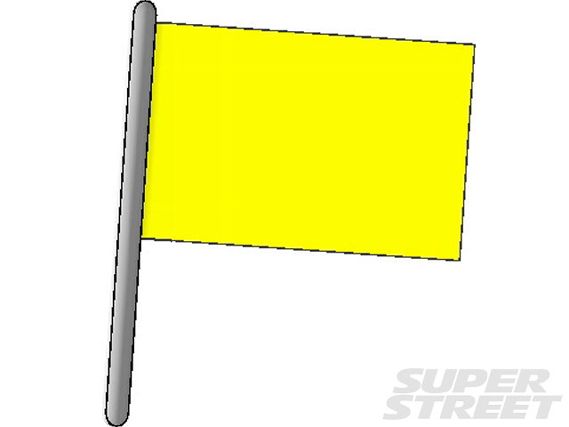 |
YELLOW: Incident ahead and the track may be partially blocked. Slow down and hold your current position on track until further notice.
|
YELLOW: Incident ahead and the track may be partially blocked. Slow down and hold your current position on track until further notice.
All events have their own rules, the most important one covers overtaking. As motorsport in any form can be a dangerous activity, consideration is the key and not doing anything likely to take anyone else off the track. The general rule is only to overtake on straights or wide corners, never in the braking zone, and to leave plenty of room. If you see the blue flag and have to move over, leave plenty of room and lift off a little to allow for a safe maneuver. However, different skill level groups will have different passing rules which are explained in the driver’s meeting.
It’s All About You: After you’ve sorted the car, there are a few basics that need that you need to attend to with yourself. Make sure you’re well rested, stay hydrated and wear sensible clothing—and a helmet. Any kind of track day will make you feel like a god and master of all things automotive, but if you’re new we’d strongly recommend picking a circuit close by for your first experience. The main reason for this is that you want to be focused and well-rested. Having to drive 300 miles before you even get out between the red and white curbstones is not going to leave you feeling this way. The other option if you fancy trying a circuit farther afield is to arrange it in plenty of time and grab a cheap motel close to the circuit—resisting the temptation to go out and get wasted in a new town the night before obviously.
Most track day organizers will insist on full body coverage (no shorts or t-shirts) and the best footwear, short of race boots, is a pair of thin-soled, flexible shoes to give you maximum pedal feel. If you don’t have a helmet, you might be able to rent one (make sure you check and book in advance), and once you’ve got the bug it is well worth investing in one of your own. As you move up through the classes, fireproof overalls and race suits will be required—especially in serious drag racing. Open or full-face lids can be bought from around $100, although motorsport-approved helmets for serious competition use will set back anywhere from $175 up to $800-1000 for a full carbon/Kevlar helmet and $2000-3000 for intercom facilities and FIA approval. Pricey, but oh-so-cool. A good range of helmets can be found from a supplier such as saferacer.com.
Drag Racing
As one of the simplest forms of motorsport, drag racing is you and your car against a quarter of a mile of tarmac. Either against the clock (bracket racing) or against another car (heads up racing), this is a sport of reaction times and concentration.
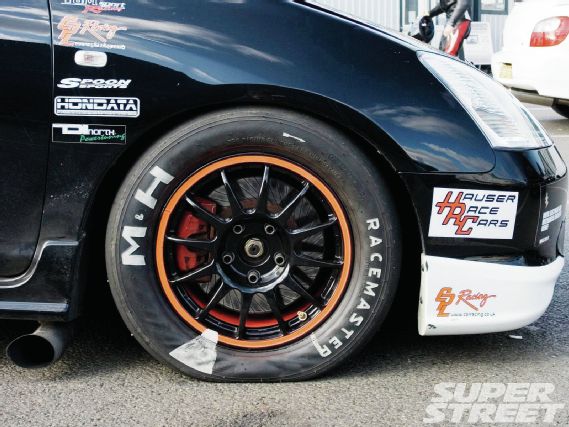 |
Chasing The Line - Tech
|
Chasing The Line - Tech
The most common form is bracket racing, i.e. against a time you’ve set yourself. For example, if you dial in a 12.5 second time, you aim to get as close to it as possible without going under it. When on the strip against another car and driver, the one who gets closest to their dialed-in time is the winner. It’s not about speed; it’s about consistency. Winners advance to the next round; losers whine about their best efforts and won’t get coffee. Heads up is simply who’s the fastest. Same rules apply; the winner goes on and the loser is still, just a loser.
There are a number of different classes (and these names may vary slightly depending on the sanctioning body), the three main ones for import drag racing are:
Noise Limits
Most circuits have them, and if they do exist they will be strictly enforced. So open pipes are a no-no and it might be worth getting the dB levels of any aftermarket system checked out as if your car is too loud you may not be allowed out on track.
Street Stock: Pretty much exactly what it says; this is the class for daily drivers and amateur strip teasers: factory turbos and internals, street-legal tires and no additional power upgrades (nitrous and the like). Intake and exhaust mods are allowed, but full interiors must be retained.
Street Modified: Street tires will still be used in this class, but otherwise pretty much anything goes. Major chassis and tuning mods are all par for the course, as long as they pass the safety inspection and adhere to NHRA rules. Depending on the event, stripping the interior may or may not be allowed—generally it isn’t.
Super Modified: Basically Street Modified but with drag radials and slick tires allowed. All other modifications are allowed as long as they comply with NHRA rules.
Safety items like approved cages, buckets seats and harnesses as well as helmets are allowed and encouraged across all classes, with only the Super Modified class requiring them.
Drag Prep
For most of us this is essentially the same as track prep: check that everything is solid, ditch the crap from your car's interior and make sure you've got the right safety gear. Fitting a headlight scoop or even just removing the headlight closest to the intake is better for cooling and it's good to invest in quality spark plugs and wires to maximize power.
For novices, the Street Stock and Street Modified classes are the ones to go for, if you're reading this and you're in the Super Modified Class, you already know the rulebook inside out and probably sleep with it under your pillow.
The most important decision to make for most is the type of fuel you're going to use: regular pump fuel or race gas. If it's the former then turn up with at east half a tank and make sure the rest of the fluids are topped up. The latter requires a coupe more considerations. Race fuel comes in many different types, the two we're going to focus on are unleaded 101 and 104 RON; don't be tempted by the higher octane ratings of leaded race gas as they will kill your catalytic convertor. It's always better not to mix the two if possible, so if you're going down the race gas road, try to run your car as empty as you dare before filling up with go-faster juice. We would also recommend buying from a race shop rather than taking a can to the track where the prices are always much higher.
The Burnout
Lighting up the tires is all part of the prep and there’s an art to it… it’s not just showing off. The burnout allows your tires to heat up for maximum traction, cleans them of any dirt and places rubber down at the start of the track. Once at the line, watch the tree carefully, breathe in and get ready. Make sure you’re in first gear (duh), hold the clutch and build the revs to around 4000-5000rpm—any lower and you’ll bog down. There’s half a second between each of the three yellow lights and the green, so get moving as soon as you see the third yellow for the optimum start. Watch the tachometer and make sure you get clean shifts (or invest in a shift light). Once you cross the finish brake gently, there is always plenty of run-off so don’t be tempted to mash the brake pedal.
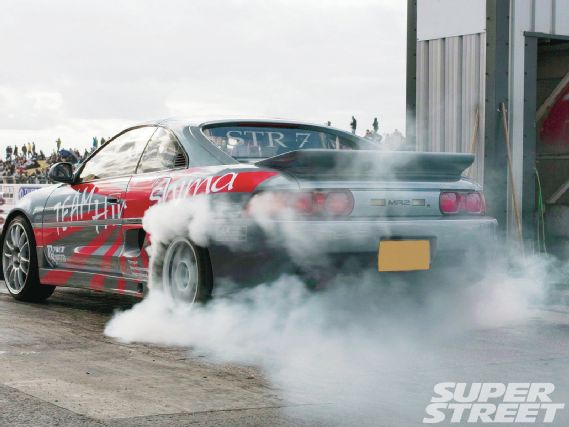 |
The burnout heats the tires and puts rubber down on the dragstrip for maximum traction, giving you the perfect launch.
|
The burnout heats the tires and puts rubber down on the dragstrip for maximum traction, giving you the perfect launch.
Insurance
Most standard auto insurance policies DON’T cover any kind of track action (usually excluded under the terms ‘racing’ or ‘timed events’), although some may offer additional cover for an extra premium. If you are in any doubt whatsoever, give them a call, and please be honest as if the worst does happen you won’t be able to fudge your way around it if there’s any evidence you’ve misled them. Specialist insurance agencies do offer an option to cover specific “driver education” events, however this coverage typically still excludes any form of racing. Our advice is to shop around and your track day organizer may well be able to offer advice and a contact to get you a better deal, so ask them when you book in (although not on the day, obviously).
Track Day Essentials
Tools: It’s worth packing a pocket-sized kit in case you need to adjust or fix anything on your car. Essentials include common wrench sizes and screwdrivers, a tire pressure gauge (possibly a tire pyrometer as well) and a rag or cloth for things like checking fluid levels. If you’re going drag racing white shoe polish is always handy for writing your dial in time on your windshield.
Fuel: Obviously you’ll burn fuel much faster on a track day, so make sure you turn up with a full tank and enough to comfortably get you to the nearest filling station after the event. If you’re taking race gas to a drag event make sure you’ve got a suitable container to keep it in.
Fluids: Spare bottles of oil and coolant are never a bad thing to have stowed in case you need to top off between sessions. Remember to allow a decent amount of cool down time before you do, of course.

